Nucella lamellosa (Gmelin 1791)Common name: Frilled dogwinkle, Wrinkled purple |
|
| Synonyms: Thais lamellosa | 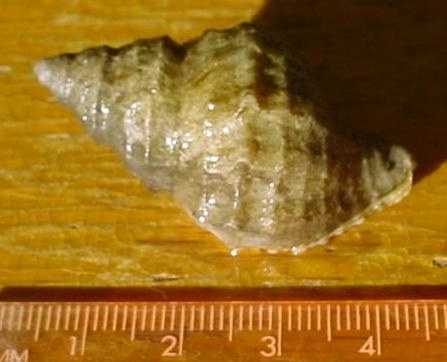  |
| Phylum Mollusca
Class Gastropoda Order Neogastropoda Suborder Rachiglossa Family Muricidae (In Kozloff's Key it is in Family Nucellidae) |
|
| Nucella lamellosa from Northwest island, at Rosario Bay | |
| (Photo by: Nathaniel Charbonneau 7/26/02) | |
How to Distinguish from Similar Species: Other local Nucella typically have no frilly axial lamellae (but see note below) and rarely exceed 3 cm in length. Nucella ostrina may sometimes look very similar but it has alternating large and small spiral ridges and the siphonal canal is less than 1/4 as long as the aperture. N. canaliculata has many spiral ridges of similar size with deep grooves between..
Linda Schroeder has added this helpful information for distinguishing N. lamellosa from N. ostrina based on the axial lamellae: : "N. ostrina can definitely have axial lamellae, but less common to see than on N. lamellosa. The lamellae are much closer together (in N. ostrina, photo) than on N. lamellosa (photo) and also don't protrude as much."
| This table lists some other general distinctions between N. lamellosa and N. ostrina:, based on information from the Oregon Institute of Marine Biology: | |
| Nucella lamellosa | Nucella ostrina |
| Habitat: Quiet water or wave action, intertidal or subtidal | Areas of wave action, intertidal |
| Shell length (height): To 5 cm or more | Usually < 2 cm, rarely > 3 |
| Shell thickness: Heavy, solid | Not heavy |
| Number of whorls: 5-7 | 3-4 |
| Outside sculpture: Variable:
Rough waters: Flattened, angled whorls which are smooth or have 1-2 strong spiral ridges near top of each whorl (photo); or ridges may be worn off (photo) |
No axial sculpture, or small, close-spaced axial ruffles. Spiral sculpture of multiple alternating large and small ridges which may be obscure or nodulose |
| Sutures: Not deep | Not deep |
| Aperture length: Nearly 1/2 shell length | More than 1/2 shell length |
| Aperture inside color: Whitish | Brown or purple (or orange) |
| Aperture outer lip: Thick and smooth, with an inner row of several denticles deep within the aperture | Thinner, often crenulate outer lip with no denticles |
| Siphonal canal: Longer than 1/4 aperture length, not closed | Shorter than 1/4 aperture length, not closed |
Geographical Range: Nucella lamellosa is found from the Bering Strait to central California.
Depth Range: Low intertidal to mid intertidal
Habitat: Rocky substrate, commonly found on mussel beds
Biology/Natural History: A most peculiar species because of its ability to vary so much in shape, color, and texture from one individual to the next. This sometimes makes it hard to key out with confidence. It is one of the most common intertidal whelks in the Pacific Northwest. Nucella lamellosa is a carnivore, feeding especially on acorn barnacles (photo) and mussels. After locating its prey the whelk uses its radula to scrape through the shell and eat out the soft flesh inside. Predators include the red cancer crab Cancer productus and the seastar Pisaster ochraceus. Prolonged exposure to chemical cues from C. productus, which cracks the snail's shell during predation, induced growth of a more rotund shell with thicker walls. Prolonged exposure to chemical cues from P. ochraceus, which reaches into the shell, induced growth of elongated shells with higher spires which allowed the snail to further retreat into the shell. These cues also stimulated the snails to seek shelter more consistently (Bordeau, 2009)
While this species is often found in somewhat brackish water of bays and estuaries, Covernton and Harley (2020) found that the population near the mouth of the Fraser River, Canada found that population size decreased after major freshwater exposures from the river. Laboratory studies found developmental delay in encapsulated embryos at lower salinity, and complete mortality at 9-12 psu. Juveniles (< 30 mm shell length) also experienced more mortality at low salinities than adults did unless they were periodically also exposed to salinities at least 20 psu.
This snail may be found congregating in large groups to breed in the spring and summer (photo). Nucella eggs are in oatlike capsules which are attached by stalks to the rocks (photo). They go through the veliger stage (normally pelagic) within the capsule and hatch as miniature snails 1 to 1.5 mm long. Adults seem to congregate back to mating swarms very near the rocks they were born at. This, combined with the fact that their larvae are not pelagic, means that breeding is nearly always with other snails of the local area, so there is a lot of genetic difference among populations in different bays, different exposures, and along the coast and identifying to species can often be difficult.
In his dissertation, Seavey (1977) reports that on the Oregon coast it takes approximately 20 months for eggs to mature in this specie. Spermatogenesis occurs throughout the year. in males. Spawning begins in June in Yaquina Bay, Oregon.
In the study by Sorte and Hofmann (2005), thermotolerance of different Nucella species along the coast was found to be correlated with the latitude range and tidal height each species occupies. N. ostrina, which occurs higher in the intertidal than does N. canaliculata in Oregon and does not extend as far north, had higher heat tolerance than did N. canaliculata. N. emarginata, which extends the farthest south, and N. ostrina, which lives higher in the intertidal, recovered more quickly from thermal exposure than did N. canaliculata and N. lamellosa, which live lower in the intertidal, and N. lima, which has a more northern range. These differences in heat tolerance may be related to HSP70 molecular chaperones.
The famous Tyrian purple dye from the city of Tyre, that colored royal
Roman robes, was made from a relative of Nucella. The snails
were ground up in a stone mortar and processed by a method that has been
partly lost to get the dye. Different combinations made different shades
of purple. The dye should be fixed with lemon juice as a mordant.
The American species produce a much less brilliant purple than do the Mediterranean
species.
| Return to: | |||
| Main Page | Alphabetic Index | Systematic Index | Glossary |
References:
Dichotomous Keys:
Carlton,
2007
Kozloff,
1987
General References:
Harbo,
2011
Kozloff,
1993
Lamb
and Hanby, 2005
Morris,
Abbott, and Haderlie, 1992
A 2023 online BBC article about making Tyrian purple dye
Scientific Articles:
Bordeau, Paul E., 2009. Prioritized phenotypic responses to combined predators in a marine snail. Ecology 90:6 pp 1659-1669
Collins, Timothy M., Kenneth Frazer, A. Richard Palmer, Geerat J. Vermeij, and Wesley M. Brown, 1996. Evolutionary history of northern hemisphere Nucella (gastropoda, muricidae): molecular, morphological, ecological, and paleontological evidence. Evolution 50:6 pp. 1-16
Covernton and Harley, 2020. Multi-scale variation in salinity: a driver of population size and structure in the muricid gastropod Nucella lamellosa. Marine Ecology Progress Series 643: pp. 1-19
Marko, Peter B., Amy L. Moran, Natalya K. Kolotuchina, and Nadezhda I. Zaslavskaya, 2014. Phylogenetics of the gastropod genusNucella (Neogastropoda: Muricidae): Species identities, timing of diversification and correlated patterns of life-history evolution. Journal of Molluscan Studies 80: pp. 341-353. DOI: 10.1093/mollus/cyu024
Rawlings, 1999. Adaptations to physical stresses in the intertidal zone: the egg capsules of neogastropod molluscs. American Zoologist 39:2 pp. 230-243
Seavy, Donald K., 1977. Seasonal gametogenesis and egg laying in the prosobranch gastropods Nucella lamellosa, Nucella emarginata, Searlesia dira, and Amphissa columbiana on the Oregon coast. Ph.D. dissertation, Oregon State University. 179 pp.
Sorte,
Cascade J.B. and Gretchen E. Hofmann, 2005. Thermotolerance and
heat-shock protein expression in northeastern Pacific Nucella species
with different biogeographical ranges. Marine Biology 146: 985-993
General Notes and Observations: Locations, abundances, unusual behaviors, etc.:
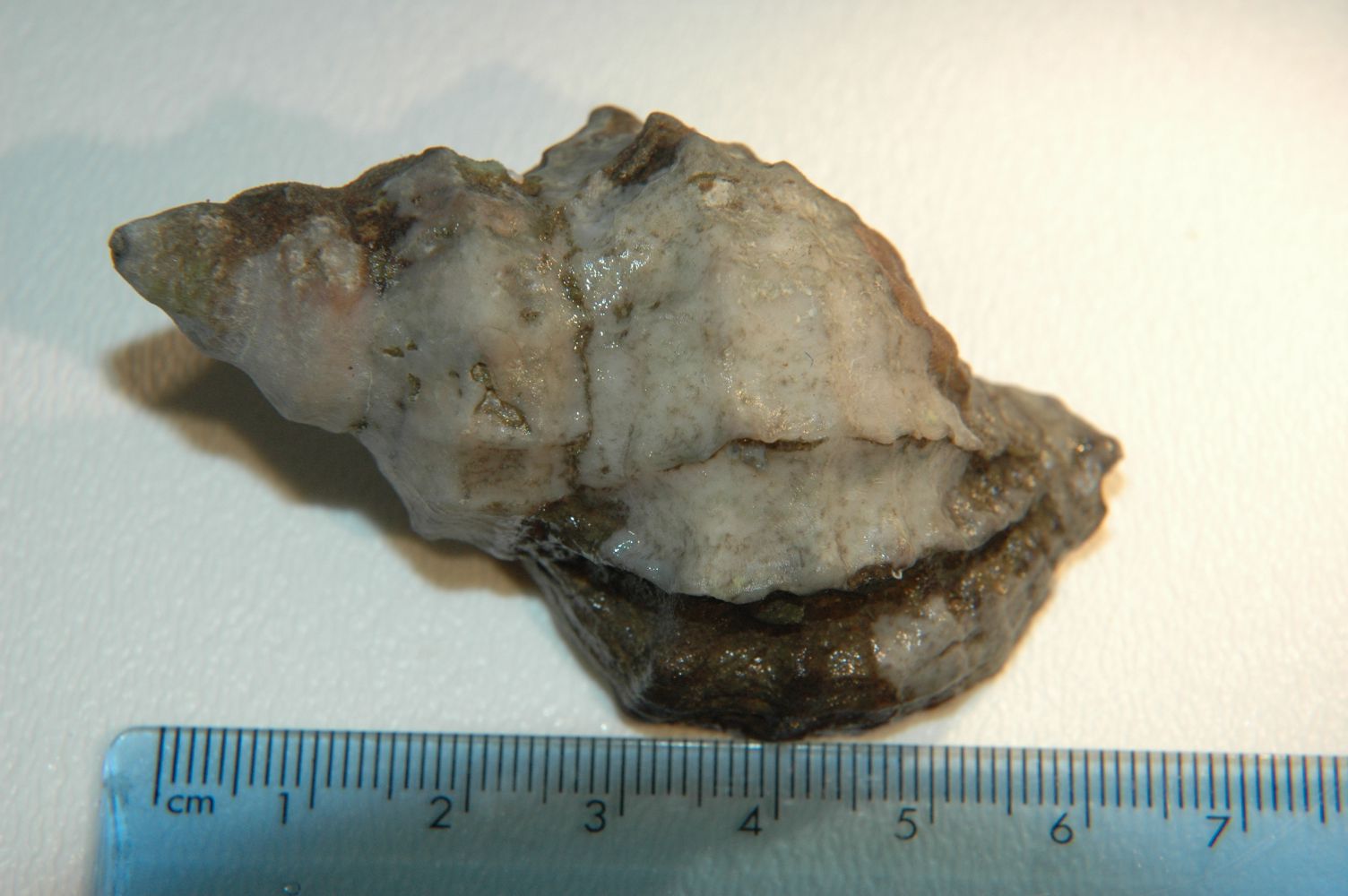
This larger individual has some frilly axial
lamellae growing from the body
whorl. Photo by Dave Cowles, July 2005
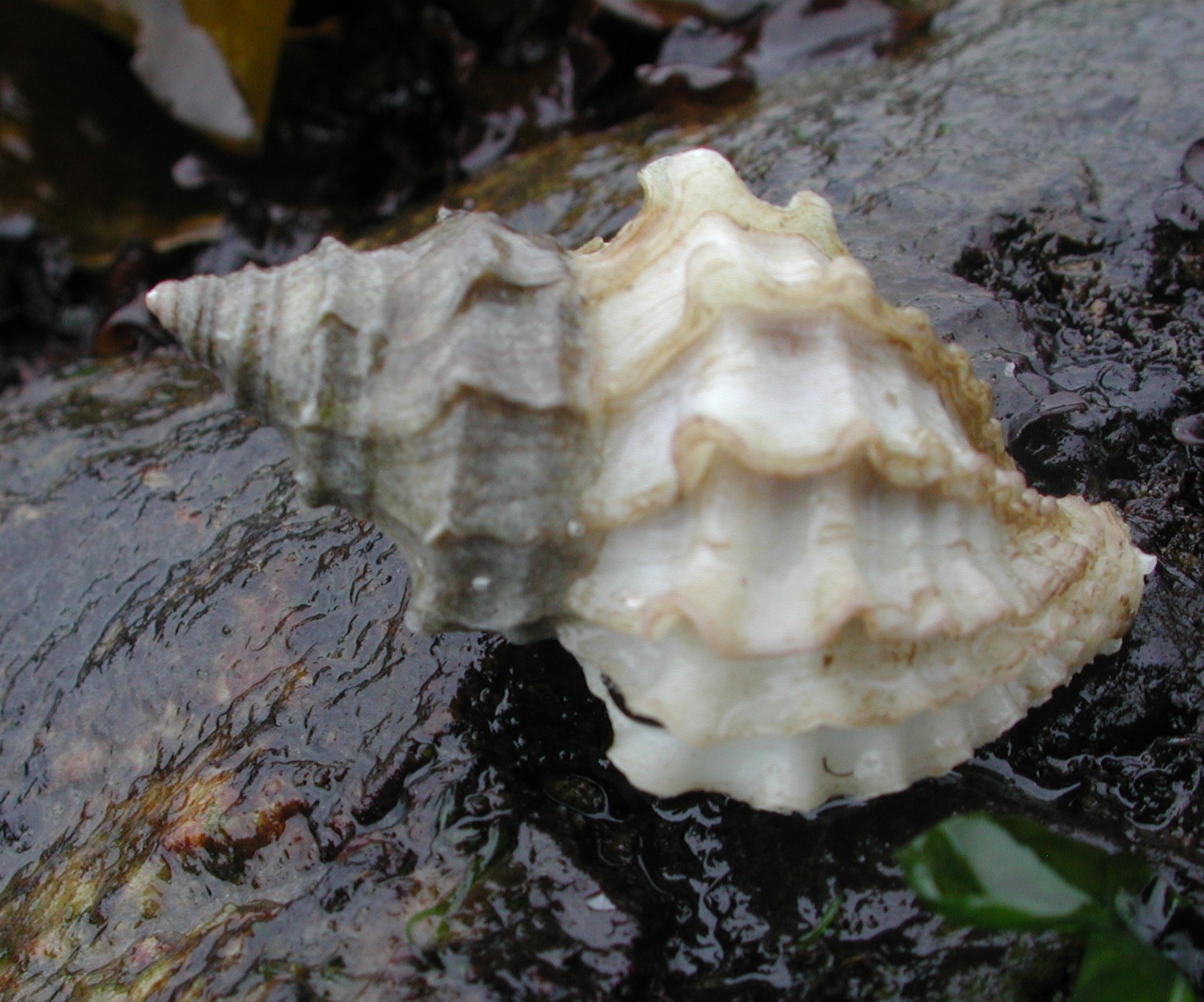
Here is another frilled individual (with axial
lamellae). Photo by Dave Cowles, July 2009
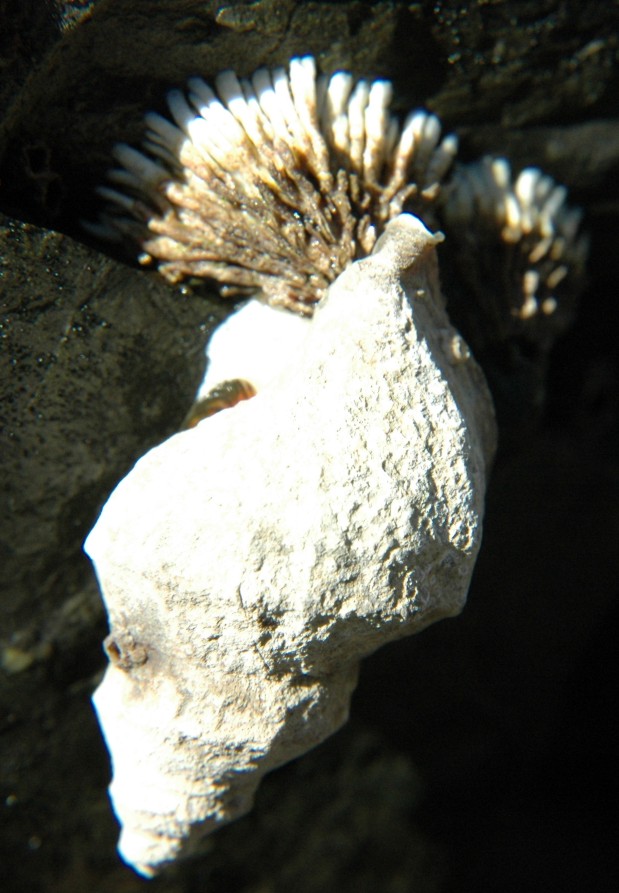
In this photo a worn Nucella lamellosa (as is often seen in
the intertidal) is eating a Semibalanus
cariosus barnacle in the intertidal
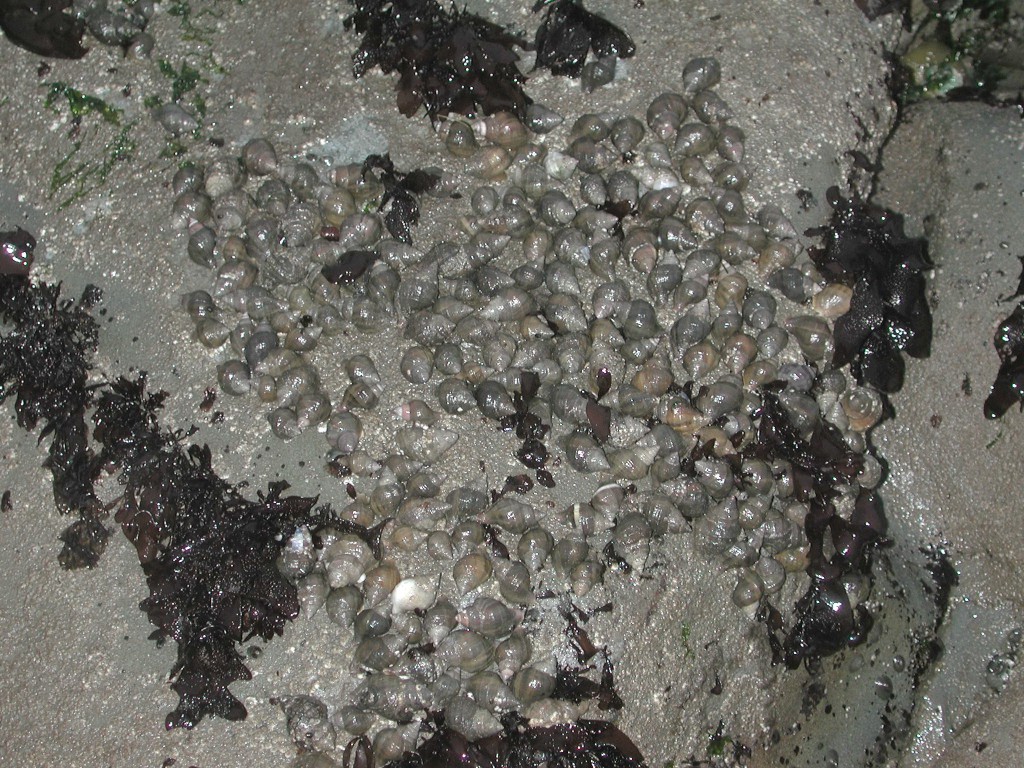
During the mating season, large aggregations of N. lamellosa
can often be found among the rocks. Often egg clusters can be found
attached to the rocks nearby (see below)
Photo at Kalaloch Beach #4 by Dave Cowles, July 2009
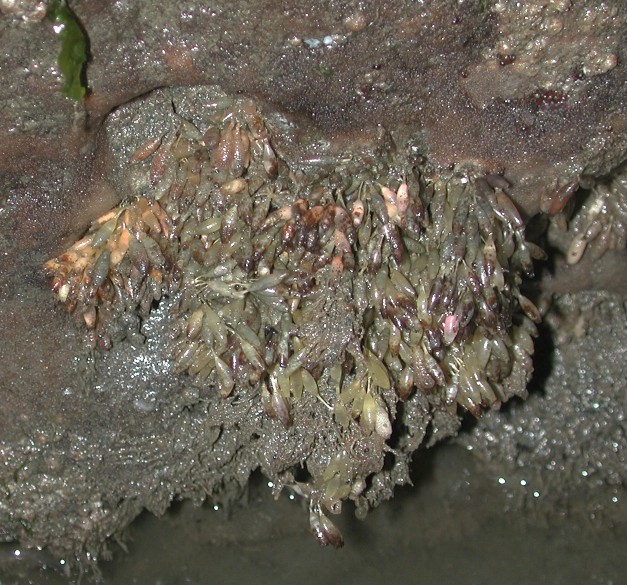
Here is a cluster of N. lamellosa eggs hanging under a rock.
Photo by Dave Cowles at Kalaloch Beach #4, July 2009
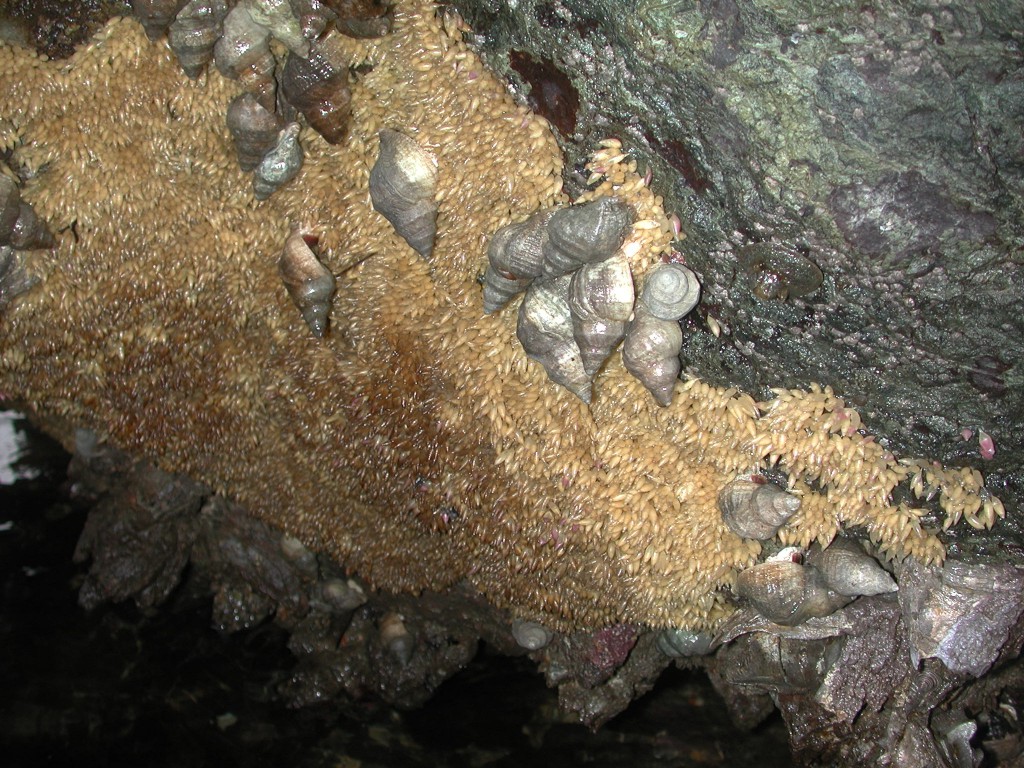
This aggregation of egglaying Nucella
lamellosa was under a boulder on Sares Head, April 2011. Photo
by David Cowles

This multicolored individual, about 6 cm long, was photographed at
Cape Flattery. Photo by Dave Cowles
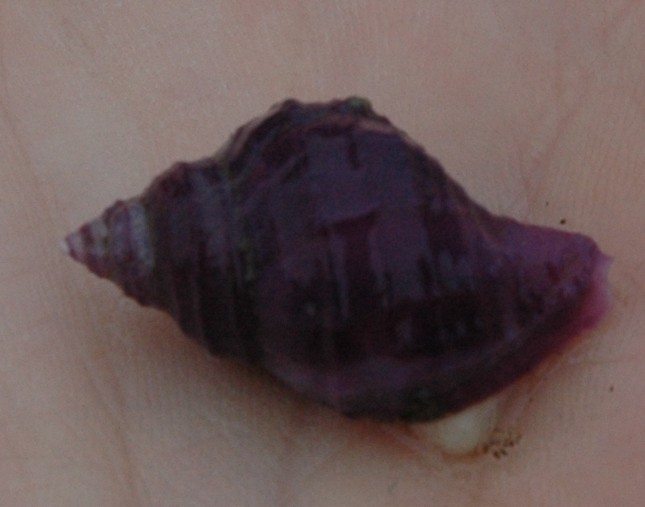
Here is an unusual purple individual (live) collected in summer 2006.
The shell is about 2 cm long.
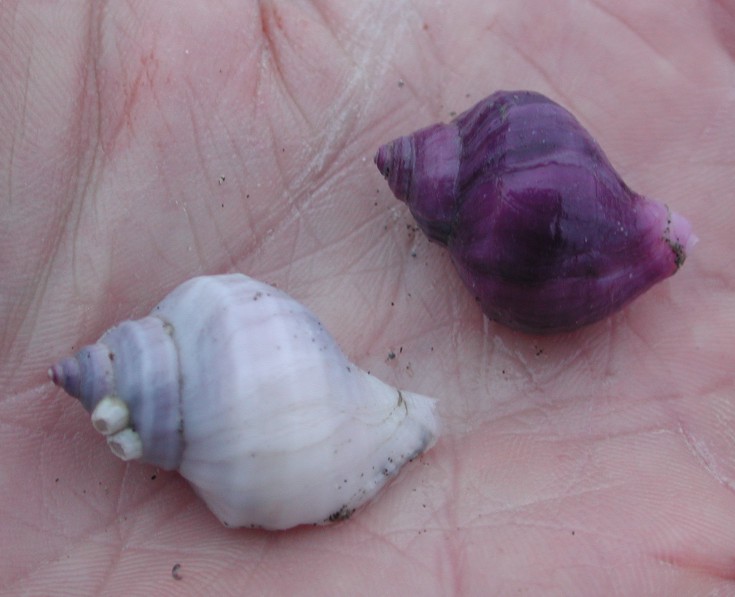
More color variation. These individuals are from a rock at Beach
#4, Kalaloch July 2008. Photo by Dave Cowles
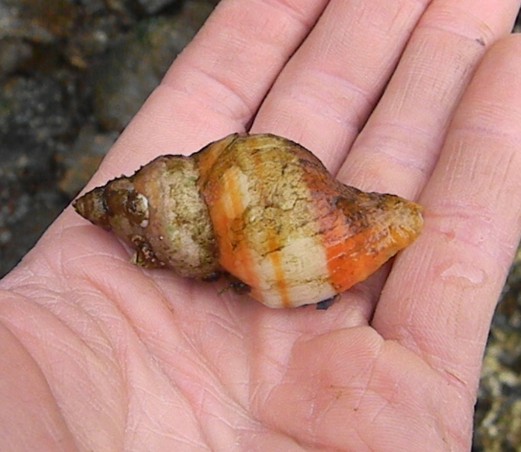
And yet more variation. This individual, at the Coupeville (Whidbey
Island) ferry landing, is nicely banded with orange. Photo by Dave Cowles,
2011
In July 2005, Jon Mayberry, Matt Henderson, and Taylor Wilkins did a student project titled "Tidal effect on daily migration patterns in Nucella lamellosa". In the study they followed vertical movements of N. lamellosa through six height zones in an aquarium during changes in water depth that simulated the ambient tidal cycle, and in a control tank that always remained full. They found that the snails in the control (full) tank continued to move all the time while snails in the tidal tank stopped moving almost entirely during low tide except for a few that fell to the bottom of the tank, making a highly significant difference in movement between the tidal and nontidal tanks at low tide. The average height of the snails differed both at high and at low tide, with snails in the tidal tank higher. This may have been due to the fact that at low tide the snails in the tidal tank "froze" in position. They also observed what might have been a migration downward at nightfall in both tanks. The figure below (figure 3 from their data) summarizes their results. Zone 0 was at the bottom of the tank, zone 6 on top.

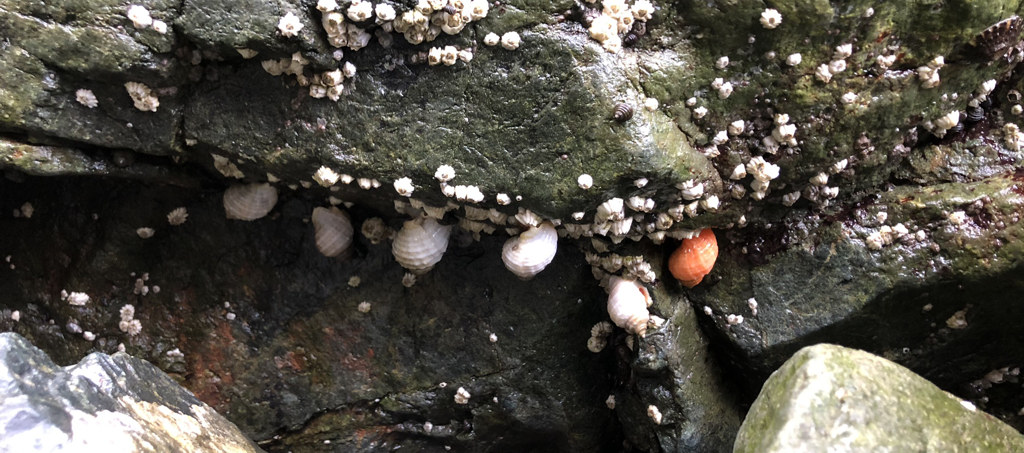
Nucella lined up on a boulder
at Kalaloch. They look like they are lined up to start a race, except one
is still out of line having breakfast. Photo by Dave Cowles, July 2024
Authors and Editors of Page:
Nathaniel Charbonneau (2002): Created original page
Edited by: Dave Cowles 8-2002, 12-2004 -
Edited by Hans Helmstetler 1-2003